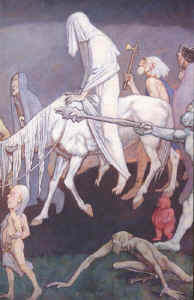|
IRISH FOMOR
The fomor is one of a group of Celtic sea demons
sometimes associated with the hostile power of nature.
Their name means the 'dark of the sea,' and they were
thought to be the opposite of all that is good in the world.
For the most part, they inhabited an underwater island,
known as
Lochlan. They often terrorized the coast of
Donegal with their monstrous appearance. All the
fomor were different from each other, not appearing
alike at all. The usual fomor was of enormous stature and
sported deformed limbs.
The
Fomorians were an ancient sea-faring race it is
thought that they originally came from Northern Africa or
Asia as they are described as having dark hair and dark skin
in the original accounts. The name 'Fomor' literally means
'beneath the sea' from the Gaelic faoi-mhuir. Today scholars
believe that 'Mor' means 'phantom' or 'spirit' and therefore
proves that the Fomorians were considered to be Gods with
magical powers.
Conaing is one of the first of these Fomorians to
have settled and they seem to have settled on all the
Northern Islands along the coast of Ireland and across to
Scotland and Norway. They were reputed to have great magical
powers. Some accounts have them living beneath the waves. It
would seem that they split up into different tribes and that
some did decide to reside in the Underworld such as Tethra
the Fomorian faery king. They were certainly renowned
Sea-farers and their ships were important to them. An
account from the Second Battle of Magh Tuiredh says
that their fleet stretched from Norway to the North-east
coast of Ireland.
|

IRISH CLIPART
IRISH HOME
IRISH MISCELLANEOUS FAIRIES |
Most Fomorians are described as
dark-haired but there are exceptions Elatha the father of Bres being
described as having 'golden-hair and being the handsomest man in
sight'. He also seems to have been less blood-thirsty and more
interested in justice. He refused to go to war with his son Bres
against the Tuatha Dé because it was an 'unjust cause'.
According to the ancient accounts in the
Lebor Gabala Erenn the
tribes of the Nemedians, Fir-Bolg, and Tuatha Dé all spoke the same
tongue and were supposed to be descended from the same family, the
Fomorians were a completely separate race. With separate language
and customs. Although they do intermarry with the Tuatha De Danann
in some accounts.
In some accounts the Fomorians are described as one-eyed, one armed,
one legged monsters with vast magical powers. In ancient times a
curse was always pronounced on someone using this one-eyed, one
armed, one legged stance as it was deemed to have great magical
power, Lugh uses this method to cast a curse at his enemies in the
Second Battle of Magh Tuiredh.
Variants: Fomorian,
Fomhoire, Formorian, Fomoraig, Faoi_mhuir.
The men of
Erin were all at the battle,
After the Fomorians came
All of them the sea engulphed,
Save only three times ten.
Eochy O'Flann, circa. A.D. 960.
